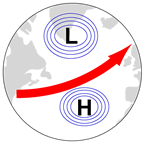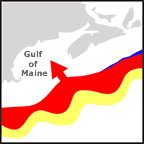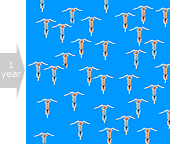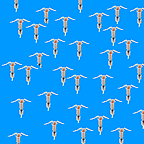Environmental Prediction in the Gulf of Maine
Forecast of North Atlantic right whale births
Overview: How are forecasts made?
The three steps described below link atmospheric changes to changes in right whale reproduction. Forecasts of whale births are based on mathematical models of the three steps, starting with real-world data on the NAO index, ocean currents, and/or food supply.
Left figure:The North Atlantic Oscillation (NAO) is a natural fluctuation in the atmospheric pressure difference between the Icelandic Low and Azores High cells. It is similar to El Niño, its more famous "cousin" in the Pacific Ocean.
Right figure: The NAO strongly affects ocean currents in the North Atlantic, including the deep currents that flow from the continental slope into the Gulf of Maine through the Northeast Channel. Depending on NAO conditions, the slope water entering the Gulf of Maine can be relatively warm or cold and carry different amounts of nutrients.
Changes in the incoming slope water occur approximately one year after the NAO shifts. GoMOOS Buoy N, located in the Northeast Channel, carries temperature sensors at depths to 180 meters that detect these changes, enabling forecasts of right whale calving rate.
Left figure: Changes in the deep currents flowing from the continental slope through the Northeast Channel lead to changes in food supply for right whales.
Right figure: Right whales primarily eat tiny, free-floating crustaceans called Calanus copepods. These plankton are the size of rice grains and resemble shrimp. Their abundance varies with the temperature and nutrients of the water entering through the Northeast Channel. The Gulf of Maine is a major feeding area for right whales during the summer.
Left figure: The amount of whale food—Calanus plankton—varies depending many factors, including water temperature and nutrient levels.
Right figure: The number of right whale babies, or calves, depends on how much food was available for the parents in the previous year or two. Although the calves are born in southern waters, the parents feed in the Gulf of Maine during summer, storing energy that is needed for reproduction. In a good year, the population of North Atlantic right whales may produce some 30 calves. In a bad year, they may produce no calves.
Because of the "chain reaction" from NAO to slope water to Calanus to whale reproduction, the number of calves reflects changes in the NAO. There is a lag of approximately two to three years between changes in the NAO and changes in right whale calving.







